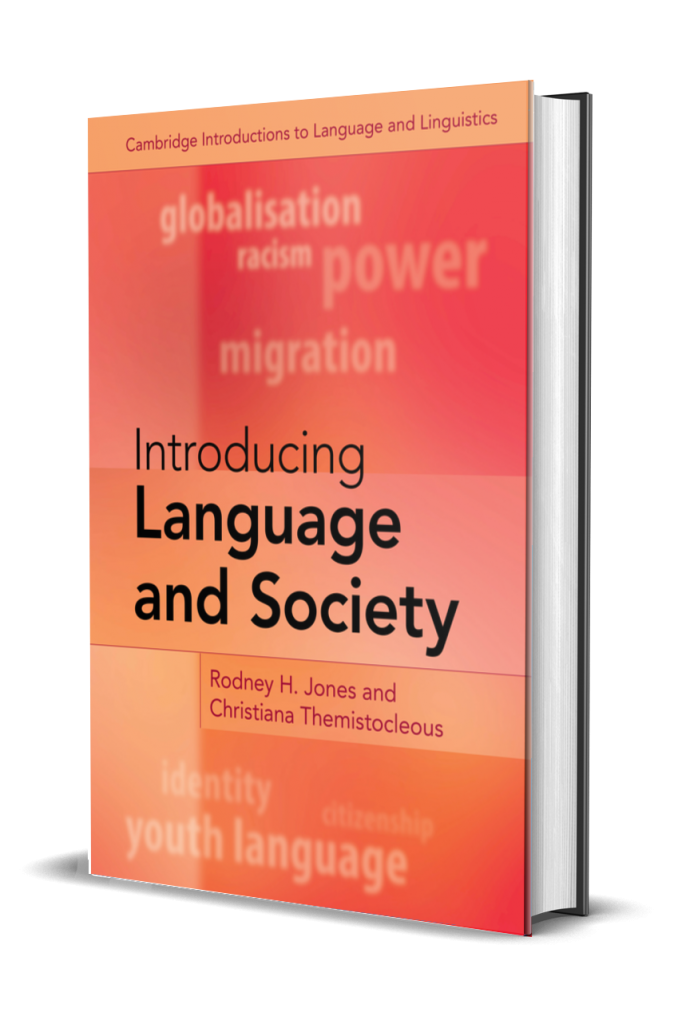
Professor Rodney H. Jones, the co-author of Introducing Language and Society, talks to us about inspiration, challenges for students, and the ‘next big thing’ in sociolinguistics.
What inspired you and Christiana Themistocleous to write a textbook on introductory sociolinguistics?
Both of us have been involved in teaching sociolinguistics to first and second year undergraduates here at the University of Reading, and, although there are a lot of good textbooks out there, we’ve had trouble finding one which is pitched at the right level and covers all of the topics we want to cover.
In particular, we wanted to be able to include in our curriculum some of the more recent approaches that have only been developed over the past five or ten years and are not featured in most of the other books we looked at. Some of these newer ideas are quite complex, and we wanted to be able to explain them to students in a way that they can understand and relate to.
Most of all, though, we wanted to develop a resource that would help us to convince our students that sociolinguistics matters! The students we are teaching are growing up in extraordinary times and dealing with a lot of challenges such as racism and gender discrimination, rising income inequality, the spectre of climate change, the circulation of misinformation and toxic discourse online, and pressures of creating ‘presentable identities’ on social media. We wanted to show them how all of these problems are ultimately mediated though language, and impress on them the power of language – how it can be used both to marginalize people and to empower them. And we wanted to use sociolinguistics as a way to provide them with practical tools that they can apply to solving personal, professional and political problems.

What are some of the new trends in the study of sociolinguistics and how are they featured in your textbook?
Sociolinguistics has changed enormously over the past few decades from the mostly quantitative studies of language variation of the 1970s and 80s to the more ethnographic and critical approaches that you see more of today. But it is not just methods that have changed. Really our entire view of what language is has changed. Rather than thinking of languages as district codes, for example, we now approach it as a more fluid set of ‘resources’ that people draw from for different purposes in different situations, and rather than thinking just of speech and writing, we now recognise how communication always involves multiple modes and materialities. When we think of resources, we are less likely to see them tied to particular places or groups (as was often the case in more traditional approaches to sociolinguistics), and more likely to engage with their mobility and the ways the social meanings and values assigned to them change as the move from one context to another. Our priorities have also changed. Although sociolinguists going back to Labov have been interested in social advocacy, sociolinguists nowadays have adopted a much more activist stance regarding the problems they research and they people that they study; they have become much more interested in questions of power, marginality, and social justice.
In the book we have tried as much as possible to incorporate these new developments while at the same time giving the students a solid grounding in traditional sociolinguistic principles and methods. So, while we include material on variationist studies, code-mixing, language attitudes, language contact, and other things that you would expect to find in a textbook about sociolinguistics, we also include material on multimodality, language and digital media, superdiversity and transcultural flows, sociolinguistic scales, embodiment, linguistic landscapes, and translanguaging.
What do you think undergraduate students find difficult about sociolinguistics? How do you address these difficulties?
There are several things students find challenging. For example, sometimes they have difficulty reading research articles in sociolinguistics, because of their relative unfamiliarity with the genre and register. To help them with this, we’ve included a ‘focal topic’ in each chapter of the book in which we systematically review two research articles about a particular topic (such as ‘language and citizenship’, ‘language and gender’ and ‘language and racism’). These summaries help to familiarize students with the way research articles are structured and provide scaffolding for them when they go on to read the original articles or similar articles.
Another thing students sometimes have trouble with is analysing and interpreting data, whether it is quantitative data from variationist studies or more qualitative data from, for instance, social media. The way to address this is to find ways to give them more opportunities to do this though, for example, the kinds of guided exercises we provide in the book, and also by getting them to collect and analyse data themselves in the context of small ‘mini-research projects’.
Planning and conducting research is, of course, the biggest challenge for undergraduate students. The main problem is being able to break down what they want to know into manageable research questions and to match those questions with suitable methods of data collection and analysis. There are also ethical issues that they need to grapple with, which can sometimes be confusing for them when, for example, they are wanting to collect data in different online environments. In the book we try to address this in two ways. First, at the end of the book we include something we call ‘A Sociolinguist’s Toolkit’ where we lay out the different research methods that students might use, the kinds of questions that they will help them to answer, and how to go about designing studies using these methods. Another way we address this is on our companion website, where we have a special section with advice to students about how to conduct research projects on different topics.
The companion website has all sorts of other useful resources as well, such as lists of useful print and online resources, further explanations of some of the more difficult concepts we have mentioned in the book, and short videos of sociolinguists whose work we have featured in the book talking about their research and what it is like to be a sociolinguist.
What do you think is the ‘next big thing’ in sociolinguistics?
There are a lot of interesting things happening now, especially in the areas of gender, raciolinguistics and intersectionalty. So much of this work takes a real activist approach and positions scholars as potential change makers, which we think is great. Issues around digital media will also be important in future work, not just because of the new linguistic/semiotic practices we are seeing online, but also in the way media interact with dimensions of language use like mobility and embodiment. And there is also some interesting work being done on affect and people’s embodied experiences of using language and other semiotic resources in different ways. Sociolinguistics is a fast-moving field, so, while we believe this book is really up-to-date, it will probably need a second edition in five years or so. At least we hope so, because that means the field is developing and growing.
The new textbook Introducing Language and Society by Rodney H. Jones and Christiana Themistocleous, is available now.
►Click here to find out more.
Latest Comments
Have your say!